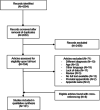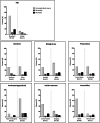Appendicitis and its associated mortality and morbidity in infants up to 3 months of age: A systematic review
- PMID: 37680208
- PMCID: PMC10480420
- DOI: 10.1002/hsr2.1435
Appendicitis and its associated mortality and morbidity in infants up to 3 months of age: A systematic review
Abstract
Background and aims: Although appendicitis is rare in young infants, the reported mortality is high. Primary aim of this systematic review was to provide updated insights in the mortality and morbidity (postoperative complications, Clavien-Dindo grades I-IV) of appendicitis in infants ≤3 months of age. Secondary aims comprised the evaluation of patient characteristics, diagnostic work-up, treatment strategies, comorbidity, and factors associated with poor outcome.
Methods: This systematic review was reported according to the PRISMA statement with a search performed in Pubmed, Embase and Web of Science (up to September 5th 2022). Original articles (published in English ≥1980) reporting on infants ≤3 months of age with appendicitis were included. Both patients with abdominal appendicitis and herniated appendicitis (such as Amyand's hernia) were considered. Data were provided descriptively.
Results: In total, 131 articles were included encompassing 242 cases after identification of 4294 records. Overall, 184 (76%) of the 242 patients had abdominal and 58 (24%) had herniated appendicitis. Two-hundred (83%) of the patients were newborns (≤28 days) and 42 (17%) were infants between 29 days and ≤3 months of age. Either immediate, or after initial conservative treatment, 236 (98%) patients underwent surgical treatment. Some 168 (69%) patients had perforated appendicitis. Mortality was reported in 20 (8%) patients and morbidity in an additional 18 (8%). All fatal cases had abdominal appendicitis and fatal outcome was relatively more often reported in newborns, term patients, patients with relevant comorbidity, nonperforated appendicitis and those presented from home.
Conclusion: Mortality was reported in 20 (8%) infants ≤3 months of age and additional morbidity in 18 (8%). All patients with fatal outcome had abdominal appendicitis. Several patient characteristics were relatively more often reported in infants with poor outcome and adequate monitoring, early recognition and prompt treatment may favour the outcome.
Keywords: appendicitis; infants; morbidity; mortality; neonates; newborns.
© 2023 The Authors. Health Science Reports published by Wiley Periodicals LLC.
Conflict of interest statement
The authors declare no conflicts of interest.
Figures



Similar articles
-
Timely recognition of Amyand's hernia with appendicitis in infants.World J Pediatr. 2015 Nov;11(4):392-4. doi: 10.1007/s12519-014-0474-0. Epub 2014 Mar 25. World J Pediatr. 2015. PMID: 24668237 Review.
-
[Amyand's hernia and complicated appendicitis; case presentation and surgical treatment choice].Cir Cir. 2016 Jan-Feb;84(1):54-7. doi: 10.1016/j.circir.2015.06.012. Epub 2015 Jul 31. Cir Cir. 2016. PMID: 26238589 Spanish.
-
Amyand's hernia with appendicitis masquerading as Fournier's gangrene: a case report and review of the literature.J Med Case Rep. 2016 Sep 22;10(1):263. doi: 10.1186/s13256-016-1046-9. J Med Case Rep. 2016. PMID: 27658707 Free PMC article.
-
Conventional herniorrhaphy followed by laparoscopic appendectomy for a variant of Amyand's hernia: a case report.J Med Case Rep. 2024 Mar 30;18(1):194. doi: 10.1186/s13256-023-04340-y. J Med Case Rep. 2024. PMID: 38553756 Free PMC article.
-
Implications of the presence of the vermiform appendix inside an inguinal hernia (Amyand's hernia): a systematic review of the literature.Hernia. 2020 Oct;24(5):951-959. doi: 10.1007/s10029-020-02215-5. Epub 2020 May 25. Hernia. 2020. PMID: 32451789
Cited by
-
Ultrasonographic characteristics of neonatal appendicitis: a case series.BMC Pediatr. 2024 Nov 14;24(1):736. doi: 10.1186/s12887-024-05192-1. BMC Pediatr. 2024. PMID: 39543518 Free PMC article.
References
-
- Karaman A, Cavusoglu YH, Karaman I, Cakmak O. Seven cases of neonatal appendicitis with a review of the English language literature of the last century. Pediatr Surg Int. 2003;19:707‐709. - PubMed
-
- Rothrock SG, Pagane J. Acute appendicitis in children: emergency department diagnosis and management. Ann Emerg Med. 2000;36:39‐51. - PubMed
-
- Philip AGS. The evolution of neonatology. Pediatr Res. 2005;58:799‐815. - PubMed
LinkOut - more resources
Full Text Sources

